Final E4000 & E5000 Review – Lushed Away

Pros –
Highly natural and coherent tuning from both models, Excellent wearing comfort and isolation, Outstanding accessories
Cons –
High-end may be too smooth and relaxed for some
Verdict –
The Final Audio E4000 suits those wanting a natural, balanced earphone with good technical performance while the E5000 suits those wanting life-like timbre and a grand soundstage propagated by meaty notes.
Introduction –
Final Audio are a legendary name in audio, a Japanese manufacturer founded in 1974 with a knack for the innovative and experimental. Their new E-series earphones may appear to be their most mainstream offerings to date, with very reasonable pricing and single dynamic driver designs, however, these earphones represent the latest acoustic engineering and psychological research. The E5000 is currently the most expensive E-series earphone at $270 USD. It represents an immediate step up from the lower E-earphones with a sealed design and removable cable. With the recent release of the B-series and A-series earphones, it can be easy to forget about the old. However, after extensive testing, the E-series earphones have stood the test of time, continuing to represent outstanding value.
Disclaimer –
I would like to thank Final Audio very much for their quick communication and for providing me with the E4000 and E5000 for the purpose of review. All words are my own and there is no monetary incentive for a positive review. Despite receiving the earphones free of cost, I will attempt to be as objective as possible in my evaluation.
Tech Specs –
Final E4000
Housing: Aluminum black alumite finish
Driver: 6.4mmΦ dynamic driver
Connector: MMCX
Cable: OFC cable
Sensitivity: 97dB
Impedance: 15Ω
Weight: 18g
Cord length: 1.2m
Final E5000
Housing: Stainless steel mirror-finished
Driver: 6.4mmΦ dynamic driver
Connector: MMCX
Cable: OFC silver coated cable
Sensitivity: 93dB
Impedance: 14Ω
Weight: 24g
Cord length: 1.2m
The Pitch –
Psychology-based Tuning
“To heighten the resolution across all ranges, acoustic pressure has been lowered. When you listen, the sound appears laid-back; turning the volume up gradually while assimilating this subtlety affords the user a comfortable listening experience. This product is one whose merits become more apparent the longer you use it.”
Final Audio combine acoustic engineering and psychological research to provide the highest resolution through the entire frequency band. With the E4000 and E5000, they’ve aimed for a smooth frequency response with seamless transitions though each core frequency band. By creating a balanced sound, Final ensure no fine details are overshadowed by large peaks or troughs attempting to artificially enhance sound quality.
Acoustic Chamber
A single dynamic driver design requires some acoustic wizardry to extract both high and low-frequency extension in addition to a desirable frequency response. Final have tuned the E4000 and E5000 using raw acoustics; an acoustic resistor behind the diaphragm feeding into an L-shaped chamber controlling back pressure behind the driver. It is known to me that most manufacturers implement a pressuriser in front of the driver to give sub-bass more solidity, however, the added resistance can overly attenuate high-frequencies which are most easily attenuated – though not directly comparable, think the range difference between a 5GHz WiFi network and a 2.4GHz network. As such, Final have effectively balanced bass and treble performance to achieve their desired characteristics. This works in culmination with high-rigidity metal housings that mitigate unwanted resonances.
Junkosha Cable
The E5000 comes with a removable MMCX cable from JUNFLON the same, in fact, as used in the Kei supercomputer. Junkosha also make fast-transmission cables for Japanese marine, aerospace, healthcare and power generation facilities. The cable’s jacket is designed to shield from EMI interference, be flexible and also mitigate microphonic noise. Cables must pass a 50,000 bend test, 10x the industry average. Cable believer or not, the build quality and level of consideration that went into this unit is very welcome.
Unboxing –
Both earphones have a similarly clean and professional unboxing experience. The earphones and accessories are well protected within a foam inlet. I am also a huge fan of the accessories themselves, with special mention going to Final Audio’s E-tips which are possible some of the best on the market. They have flexible stems that contour better to each listener’s ear canal. However, unlike Spinfits, the sound tube is unimpeded and, therefore, the sound has higher fidelity without taking personal preference for sound and into account, of course. The case is also excellent and unique. It has a silicone construction with flexible lid that snugly presses into the earphones and nestles them firmly into the case. This stops the metal housings from colliding and scratching each other during transit. Furthermore, the round shape permits the earphones to be coiled which promotes longevity for the cable.
Design –
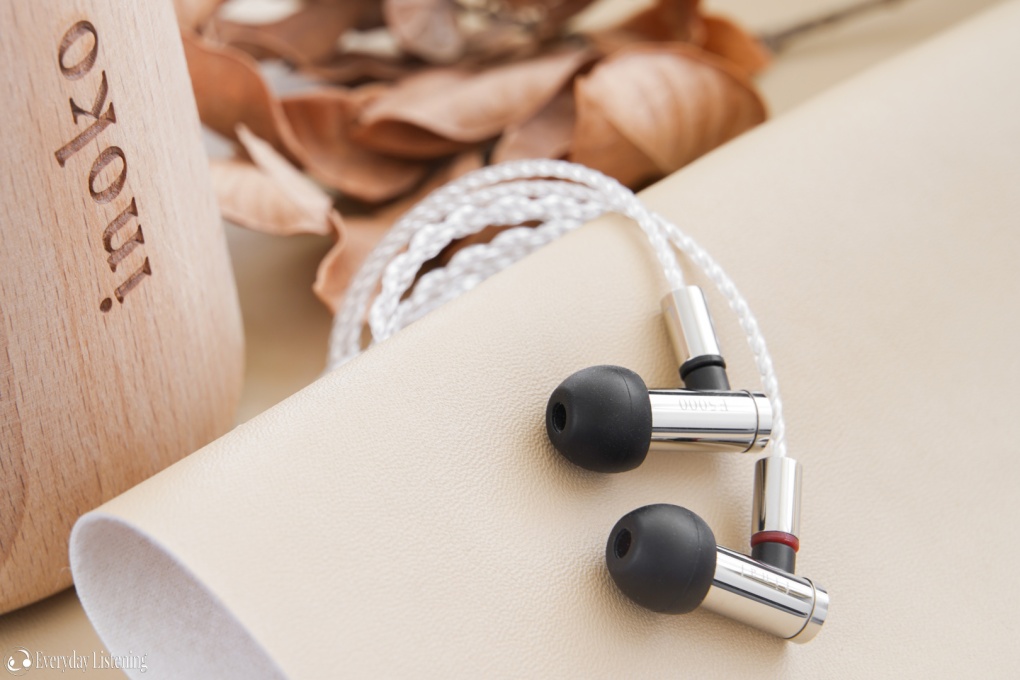
Both earphones resemble the lower E-series earphones that came before bolstered with superior build quality and the addition of a removable cable. Once again, I find myself admiring the beauty in their simplicity, with long, bullet-style housings that accommodate cable up and down wear equally well. The cleanliness of the anodized aluminium E4000 and chrome stainless steel E5000 are fascinating to the eye. Both earphones are no longer so obviously open with sealed backs and just a small port on the bottom of the rears.

The cables are also much improved over their predecessors, now removable with a standard MMCX interface. The E4000 implements a standard plastic cable, it has a smooth sating texture and excellent suppleness in the hand. The channels are divided beneath the Y-split which may split over time, my unit did not have this issue. The E5000 has a substantially nicer cable with smoother texture and a braided construction. It has silver-plated conductors and is noticeably more sophisticated. This cable too is quite compliant if a little springier than the E4000’s cable. The E5000 also flaunts its premium status with matching chrome terminations while the E4000 makes do with rubber and plastic. Nonetheless, both have excellent strain relief on their right-angle jacks and are low-profile elsewhere.
Fit & Isolation –
By Virtue of their minuscule dimensions, the Final E-series earphones produce perfect wearing comfort no matter how long the listening session. Worn over-ear or cable down, microphonic noise is mitigated by the elongated housings that distance the cable from the face. As the earphones don’t contact the outer ear, no hotspots are formed, they simply disappear in the ear.
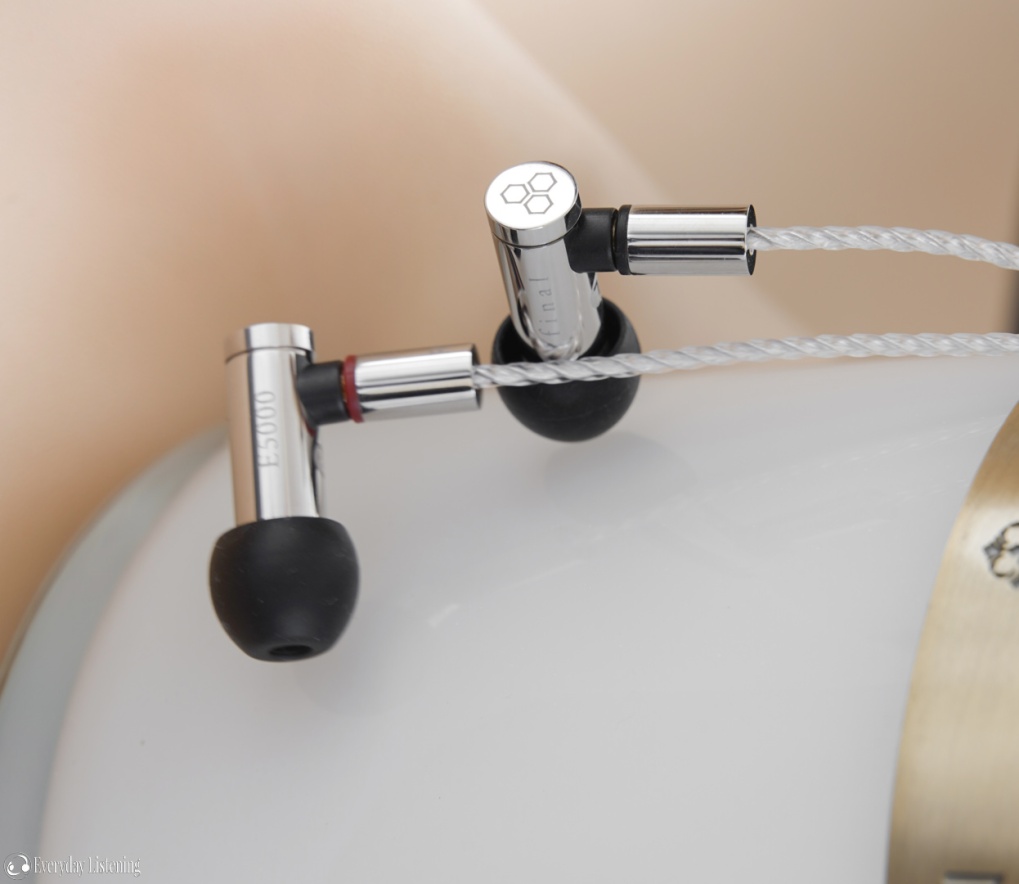
Isolation is also very good for a vented dynamic driver earphone. I can only presume this is due to the resistive nature of their vent which likely works to block some external noise too. As such, these earphones isolate almost as well as sealed earphones making them an excellent choice for commute and travel especially alongside foam tips. That said, as none are included, these will have to be sourced separately.
Sound –
Final E5000
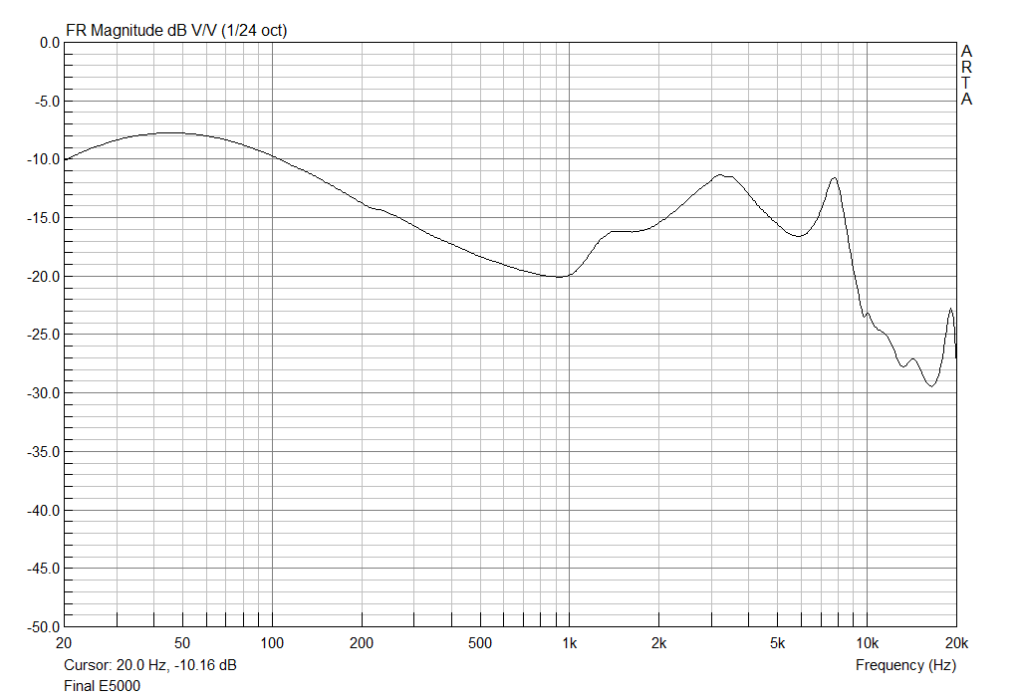
Tonality –
The E5000 has a warm, roughly L-shaped sound with a highly natural tone and an intoxicating sense of space. Bass is clearly enhanced and holds most prominence in its sound with large sub and mid-bass presence. The midrange is laid-back but very linear, lightly warm in tone and modestly full in body. It’s creamy smooth and with a gorgeous natural timbre. Finally, the high-end is smooth and inoffensive with smooth articulation and attack but rapid transients that maintain good clarity. True to Final Audio’s research-based tuning methodology, there isn’t a hint of sharpness nor whiff of an intrusive peak. This high-end won’t suit those wanting a crisp, high-energy sound but impresses with strong extension and great cleanliness.
Bass –
Thick, warm yet discerning, the E5000’s low-end showcases the fruits of Final’s efforts. I was shocked to hear so much sub-bass extension coming from a micro-driver earphone. The low-end on the E5000 extends into the physical, delivering tight, solid slam and highly defined rumble. There’s moderate emphasis here alongside a fairly large hump in the mid-bass, imbuing the low-end with a euphoric warmth and great fullness. The upper-bass is slightly attenuated as is the lower-midrange in order to slightly clean up their presentation. This is no doubt a bassy earphone and not for those seeking balance, but in fairness, never one that is overwhelmed by said bass.
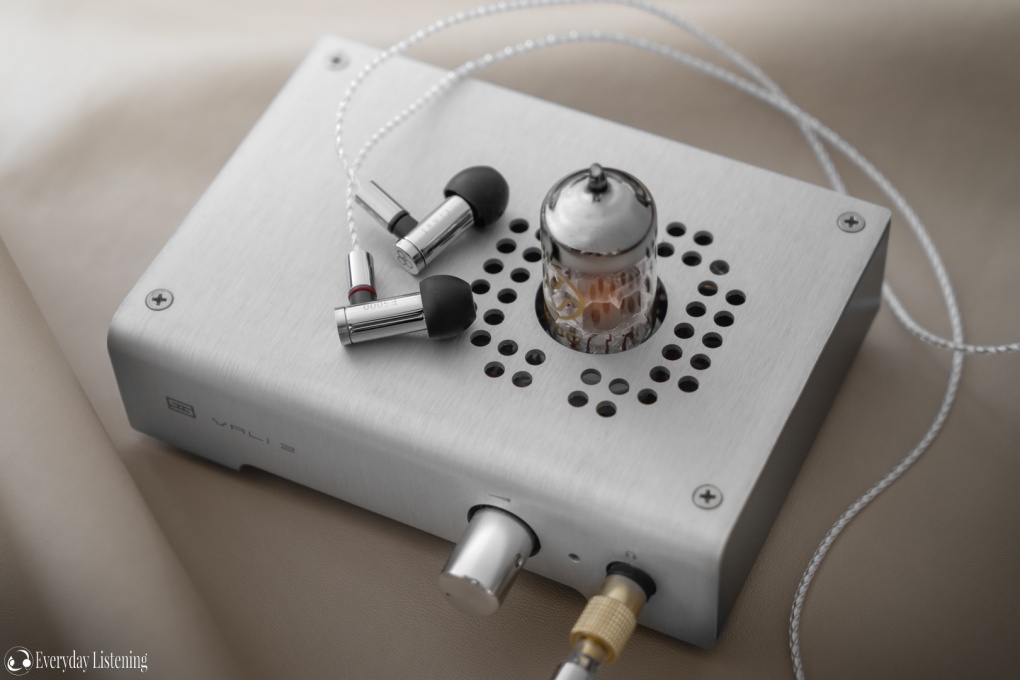
In fact, the quality is simply stunning, this is truly excellent execution. Final have effectively appended any issues with extension associated with micro-drivers while keeping its agility intact. Driver control is incredible, outclassing similarly priced earphones. Decay is natural and these earphones are extremely discerning of bass texture and detail. They are highly defined if smoothly textured. Nonetheless, driver control is so rigid that muddiness and bloat don’t mire their image despite being present on behalf of their tuning. The E5000 is a terrific performer, bringing great body and rumble with the poise and precision of a much pricier model.
Mids –
The midrange is where things can get strange for earphones around this price and frequently it’s due to the tuning in the bass or treble adding excessive colouration. Final have instead toned down the high-end and, in so doing, have granted the midrange space to breathe. It is laid-back which may not suit some, however, I’m absolutely enamoured with the E5000’s vocal timbre and overall highly natural presentation. This isn’t a neutral earphone nor would I consider it perfectly transparent. Instead, the E5000 is warm and full-bodied counterbalanced by excellent vocal clarity and perfectly smooth articulation. Vocals just sound… right.
More specifically, the E5000 possesses great balance between clarity and body, smoothness and extension. As the upper-bass is quite clean, male vocals are never chesty or veiled but clean in tone and full-boded. Similarly, though the upper-midrange has been brought a touch forward to enhance clarity, balancing out some of their warmth and body. Yet, as the lower-treble and 4KHz regions are both smooth, the upper-midrange is dense and without a hint of rasp, thinness or sharpness. These earphones are simply delightful to listen to, delivering coherent, wholly resolved notes with excellent resolution on top.
Highs –
I believe this is the frequency range which either makes or breaks this earphone for the majority. This is so because the E5000 is very unoffensive and smooth here. It isn’t an explicitly dark earphone as there is some crispness and ample detail presence to engage, but it has no sort of emphasis or clarity lift. Instruments are well-bodied and warm with good texture. I do hear a slight truncation of cymbal shimmer and strings as they extend into they darker middle-treble. Still, there’s good extension and an immaculate black background that creates a highly engaging sense of distance, aiding the dimensions of their soundstage.

On the contrary, treble isn’t especially crisp and they can sound even detail deficient on first listen, requiring some time to adjust. Surely these are not for those wanting aggressive detailing and attack. Instead, the E5000 is layered, clean and composed. It has quick transients and great retrieval of small details but is very smooth in its delivery. The E5000 has fairly strong resolution, especially for a cheaper single dynamic driver earphone. But there isn’t much sparkle or micro-detail in the highest octaves as one could imagine. The E5000’s high-end services its sound, adding dimension and upholding terrific cleanliness and smoothness.
Soundstage –
With strong extension and a dark background, the E5000 crafts a large soundstage presentation. Width extends beyond the head as does depth, creating a well-rounded and coherent presentation. Imaging is very interwoven and, to return to an aging descriptor, natural. Vocals are strongly centred while instruments are organised to the sides. These earphones aren’t hyper-separated but delivers bold, whole notes with great coherence. As the image is highly defined and transients are swift, directional cues remain easily locatable and very involving. Each element occupies none other than its rightful space. There isn’t an abundance of air around each element if that’s your sound, but the soundstage is surely a highlight of the E5000, very involving.
Final E4000
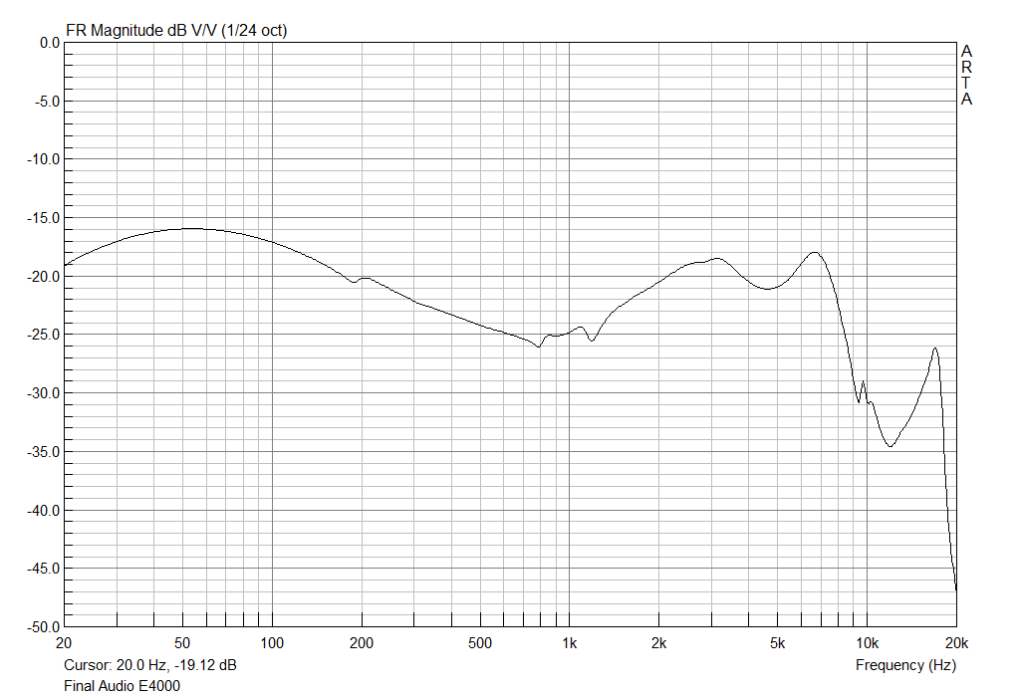
Tonality –
I’ve chosen to put the E4000 second as the E5000 surely represents Final Audio’s pitch best. The E4000 very much resembles its pricier sibling with a roughly L-shaped signature, however, it introduces a more balanced signature with less warmth and body. Lows are warm and full, but are more linear than the E5000, with less mid-bass focus. As such, their tone isn’t as warm nor are they as full-bodied in general. The E4000 has more vocal presence and greater balance overall. Its high-end is more present and crisper with a small 7KHz emphasis as opposed to the completely smooth E5000. The E4000 is the more transparent of the two earphones and also the more mainstream in terms of tuning, however, in so doing it loses some of the same magic with regards to staging and composition.
Bass –
Where the E5000 has bold, thick and warm notes, the E4000 is cleaner and more linear. It retains terrific extension into the physical alongside moderate sub and mid-bass emphasis with a touch of bias towards the mid-bass. However, this earphone doesn’t have the same boominess as the even bassier E5000. Similarly, the E4000 mitigates some of the added warmth and fullness with a neutral upper-bass and slightly recessed lower-midrange to prevent excessive vocal colouration. As such, this earphone comes across as more linear with a more accurate low-end timbre.
I raved about the E5000 and it is with regards to extension and control that the E4000 similarly rewards listeners. It isn’t quite as controlled and detailed as the E5000, however, as it has a cleaner tuning, it is similarly defined with a touch more separation. The E4000 similarly carries natural decay yet its notes lack the keen resolution of the E5000. As such, its texture is smoother and fine details aren’t quite as apparent. Nonetheless, those concerned the E5000 will be too bassy for their preferences will surely find appeal with the more balanced, less bloated E4000.
Mids –
Here, the E4000 also diverges from its sibling, being more balanced with greater vocal presence. It remains a very natural earphone and one with slightly higher clarity but without those perfectly whole notes. To clarify, this earphone similarly climbs to 3KHz prominence before a small dip at 4KHz for density and smoothness. However, as it has less low-end presence and a more forward centre-midrange, vocals occupy similar prominence to bass and are more neutral in body, the tone also isn’t as warm.

Furthermore, the lower-treble and upper-midrange are both more present on the E4000. This permits greater clarity but also introduces a hint of over-articulation into their sound. Nonetheless, this too is a highly smooth earphone devoid of sibilance and with an excellent timbre that sounds correct and faithful. However, the key differentiators are with regards to body and note resolution which are both noticeably higher on the E5000 if at the cost of vocal extension and clarity.
Highs –
The E4000’s top-end indeed carries more detail presence and crispness. Percussion is more forward and notes have a sharper attack than the smoother and darker E5000. In the grand scheme of things the E4000 remains a fairly smooth earphone, certainly not peaky or aggressive in its own right. It is similarly, well-textured and detailed with slightly bolstered instrument body. That said, the E4000 is a touch splashy up top with the E5000 being cleaner and more extended.
As the E4000’s foreground is more prominent, its similarly black and immaculate background can become overshadowed along with smaller details that reside here. As such, though the E4000 provides the impression of greater detail presence, detail retrieval is not as high overall. Still, this is a sound densely propagated by fine nuances if a slightly uncontrolled splashiness not present on the E5000. Resolving power remains high for an earphone of considerably lower cost and again we observe minimal sparkle or micro-detail if newfound energy within the lower-treble.
Soundstage –
The E4000’s treble extension permits a fairly large soundstage that extends just beyond the head. It’s noticeably more intimate than the E5000 on behalf of its more forward vocals and brighter top-end with less extension. That said, it is similarly rounded with excellent imaging. The E4000 has a coherent presentation over crafting hyper-defined layers. Vocals have a very strong centre image while instruments possess their own space to the sides. Directional cues are sharp but transients aren’t quite as swift as the E5000. Separation is higher than the E5000 throughout with a little more air around each element, however, as the highs are less even and linear, the lower-treble can overshadow some background details here.
Driveability –
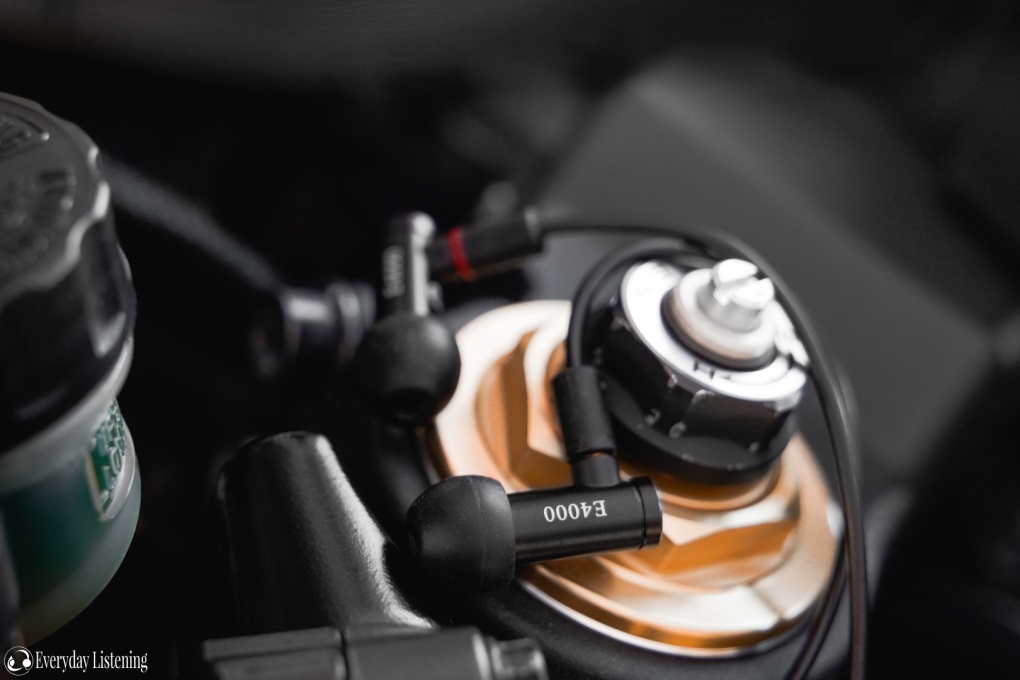
The E5000 has a very low 93dB sensitivity paired to a lower 14ohm impedance while the E4000 is more sensitive at 97dB with a 15ohm impedance. Both require a lot of power to reach high or even moderate listening volumes. As such, a dedicated source is recommended and, from my testing, the higher end E-earphones thrive with power in terms of driver control too. For instance, from my Google Pixel 4 dongle, though a single driver and impervious to both output impedance and hiss, both sounded pretty muddy and ill-defined. This changed very quickly when listening from the Earmen TR-AMP where lows were quickly reined in much to the benefit of balance and separation, creating a more involving soundstage. The E4000 and E5000 will sound okay from a smartphone but definitely benefit from a bit more power such as a dedicated source or, at the very least, one of the higher-end BT receivers.
Comparisons –
Final E5000 vs Final E4000: The E4000 represents a more balanced but less technical sound while the E5000 is bassier, smoother and more refined. Both have terrific sub-bass extension, the E5000 has more mid and sub-bass, granting it a fuller albeit slightly boomier presentation. The E5000 has superior driver control retrieving more fine detail where the E4000 is a touch cleaner and more separated. The E4000 has more vocal presence and clarity while the E5000 is smoother and more accurately articulated. The E5000, therefore, boasts the more natural timbre while the E4000 is more balanced. The E4000 has a more forward lower-treble being crisper with more forward treble instrumentation. Meanwhile, the E5000 is smoother and more controlled with better extension. It has more background detail retrieval and a larger soundstage with better positioning.
Final E4000 vs Shozy CP ($165): The CP is a bit more balanced with less bass in particular. It has less bass extension by a fair margin in addition to less bass. Bass is more linear on the CP and fuller on the E4000. The CP has quicker decay and more bass definition while the E4000 has more depth and is more dynamic. Through the midrange, the E4000 is more natural, with more accurate body and a smoother top-end. It also has more natural vocal extension due to its more linear upper-midrange tuning where the CP has a touch more vocal presence but is also slightly truncated. Still, both are very natural and have accurate timbres but the E4000 sounds a bit more refined at the cost of separation and layering. The CP has a crisper lower-treble while the E4000 is smoother with more instrument body and texture. The E4000 has more background detail retrieval and sounds more natural here. The E4000 has a larger soundstage while the CP has better separation and layering.

Final E4000 vs Dunu Falcon-C ($200): The Falcon-C is a more U-shaped earphone with a cleaner tone throughout and more forward lower-treble. The Falcon-C has a cleaner low-end with just a touch less extension but greater balance and linearity. The E4000 is warmer through the mid-bass and less separated. Both have similarly excellent driver control with the main differences being in presentation. The Falcon-C has slightly more vocal presence with greater centre midrange emphasis while the E4000 sounds more natural with a more progressive climb and upper-midrange focus. The Falcon-C’s forward lower-treble makes it sound quite raspy and over-articulated where the E4000 is smoother and more refined. Otherwise, the Falcon-C is quite a natural sounding earphone and some may enjoy the extra glossiness. The Falcon-C has a much sharper and more aggressive lower-treble. The E4000 has a lot more instrument body and texture. The Falcon-C extends slightly better with more resolution and micro-detail. The E4000 has a larger soundstage with more accurate positioning due to its greater linearity.
Final E5000 vs Periodic Be – Mod ($299): Two similarly priced dynamic earphones with excellent driver quality. The modded Be is more balanced with less bass and it has a crisper but not excessively sharp treble, it is an option for those that worry the E5000 may be too bassy or relaxed. The E5000 has slightly better sub-bass extension as the mod takes off some slam. Both have similarly high driver control, the E5000 has a more boldly defined mid-bass and greater dynamics where the Be is smoother, cleaner in the mid-bass and slightly quicker decaying with higher separation. Both are also natural through the midrange, full-bodied and lightly warm. The modded Be is more balanced while the E5000 is more laid-back. The E5000 is warmer while the Be is similarly full-bodied but has a more accurate tone. The Be has a touch more clarity while the E5000 is smoother, both have accurate articulation and timbre. The Be has a noticeably crisper lower-treble. As the 6Khz region is smooth, it isn’t sharp in the slightest but brings more detail presence and energy without thinning out body too much. Meanwhile, the E5000 is more relaxed with greater texture and a blacker background. The E5000 has more extension and a larger soundstage with more precise direction cues. Meanwhile, the Be has better separation and more air. These are two very fine options that punch above their weight.

Final E5000 vs Hyla CE-5 ($940): Regarded as one of the highest quality DD implementations, the Hyla has a tremendously enjoyable low-end and a more complex driver setup at a more complex price. The Hyla is more V-shaped with a noticeably more potent high-end. The E5000 has more prominent bass and it is a lot warmer with more mid-bass focus. The Hyla is more sub-bass focussed, neutrally toned and more controlled. Both have natural decay and excellent extension, the Hyla is a lot cleaner and noticeably tighter. Through the midrange, the E5000 is more relaxed and laid-back where the Hyla is brighter and clearer. It has much thinner body and little warmth as opposed to the full and euphonic E5000. With more upper-midrange bias, the Hyla has better extension but is more intense and can sound a bit dry and thin, especially with male vocals. Through the highs, the Hyla is a lot more aggressive, however, it also has a big lead in technical ability. Lower-treble is a lot crisper and more energetic with less instrument body but great texture and substantially higher detail retrieval. Extension is a lot better on the Hyla with more background detail retrieval and a lot more sparkle. It isn’t more natural but is certainly more technically proficient. This can also be felt in the soundstage where the Hyla is similarly expansive soundstage but with sharper directional cues. Its background isn’t as immaculate, but separation is higher with cleaner transients.
Verdict –

Naturally, with such bold claims on Final Audio’s behalf, some scepticism is due. And yet, what I discovered with their higher-end E-earphones was a sound that was sophisticated and mature. The E5000 best exemplifies Final Audio’s mantra that less is more. For at their centre, these are basic earphones; in design and in structure with a single-dynamic doing all the heavy lifting bottom to top. Don’t let that fool you, whether you opt for the slightly more balanced E4000 or the richer E5000, these earphones present coherent notes, wicked smooth vocals and a highly immersive soundstage. With these earphones, we can finally lay the driver count war to rest and witness the rise of the mighty yet humble single DD. These are terrifically well-realised earphones, showcasing how implementation trumps specification every time. The Final Audio E4000 suits those wanting a natural, balanced earphone with good technical performance while the E5000 suits those wanting life-like timbre and a grand soundstage propagated by meaty notes.
The Final Audio E4000 and E5000 can be purchased from Hifiheadphones for £119 and £219 respectively at the time of review. I am not affiliated with Hifiheadphones or Final Audio and receive no earnings from purchases through this link.
Track List –
AKMU – SAILING
Billy Joel – The Stranger
Cream – Wheels of Fire
Crush – Digital Lover
Daryl Hall & John Oates – Voices
Dire Straits – Communique
Dirty Loops – Next To You
Fleetwood Mac – Rumours
H.E.R – I Used To Know Her
Joji – Sanctuary
Kanye West – Ye
Radiohead – OK Computer
TALA – ain’t leavin` without you
The Beatles – Abbey Road
The weeknd – After Hours


Hello. I was wondering how you compare the E4000 and the Campfire Comet? Both in noise isolation, and sound tuning.
Thanks for the review.
LikeLike
Thanks for your kind comments,
The Comet has less bass extension and less sub and mid-bass quantity, but similar low-end warmth as it has more upper-bass, bass is faster with slightly better definition on the Comet. Vocals are also slightly more neutral in tone and body and they are more forward on the Comet but not necessarily too shouty or intense as the 4KHz region has a large dip. The Comet has a crisper and thinner treble, it is more upfront while the E4000 has a smoother top-end. The E4000 has a larger soundstage.
Cheers,
Ryan.
LikeLike
No one mentions that the mmcx connection is too close to the tip and does not allow of deep insertion into the ear (much better done in the old Heaven series design). This forces over ear use on some users.
I also found the mid range on the e4000 a bit underwelming with vocals
LikeLike
I personally didn’t have this issue, you can also size up the tips and you will get a shallower fit while maintaining seal.
What did you find underwhelming about the e4000’s vocals and what are these comments in reference to?
Perhaps I can give other tips and recommendation.
Cheers,
Ryan.
LikeLike
f
LikeLike
How would these compare to Westone um pro 30?
I have a custom um pro 30 and listen to a variety of genres from classical film music to heavy metal and even jazz or bluesy acoustic stuff.
However I have extremely tiny ears so I’m not sure if I can do better than Es30 customs without experiencing discomfort
LikeLike
@spie If you can I suggest getting the e1000 to have a good idea of how the E-series fit. Since the e1000 is very similar is size/shape and cheap. You can always gift it to someone afterwards. Just my opinion.
LikeLike
Good thinking sounddouble! Regarding the fit, you can definitely try the lower end models as the housing diameter is identical. That said, I am quite confident that these will fit even smaller ears, though long, they’re very compact and when worn over the ear can be angled freely to suit the shape of your outer ear.
It’s been a while since I’ve listened to the UM30 Pro, I remember a fairly clean and clear sound with light low-end warmth but nothing like the UM50 Pro. The E4k/5k will be a lot bassier, better extension and more bass texture, they will also be warmer and fuller sounding earphones. The UM30Pro has a crisper top-end with more treble attack and emphasis on percussion while the Final earphones will be smoother, darker and cleaner with larger soundstages. I think these qualities make the Final earphones quite genre versatile, if you prioritise more balance, the E4000 will likely be most familiar coming from the Westone.
Cheers,
Ryan.
LikeLike
Hi,
I’m searching for some new IEM to replace my very old Ultimate Ears Triple Fi 10.
I was just about to buy Campfire Audio IO when I found this review. I’ve listened to IO quite a few times and I love how it sounds. However based on your review I think one of these Final Audio earphones might be just as good for me. I listen mostly to smooth guitar jazz, 80’s rock and pop, male singers and some lounge music like Michael E etc.
Do you think that these IEM would be suitable for my needs?
And also – I will most likely listen to Spotify set on the highest bitrate on iPhone SE or later on the new iPhone 12. Are these devices powerful enough to drive these earphones?
Thank you very much for your help!
David
LikeLike
Hi David,
I realise I probably should have included the IO in comparisons!
Compared to that model, the E5000 will give you a much more potent bass and a smoother treble. The vocals aren’t as clear or defined but will have a more natural tone, body and articulation. If you enjoy the IO, then I would be cautious to jump to the E5000 since the presentation is quite different – you may enjoy clarity over absolute accuracy. That said, I do enjoy them for the genres you listen to, they have a nice rich, “analogue” style sound that’s great for jazz and male vocals.
In terms of listening from an iPhone, I did try them with my iPhone XS and included dongle. They were slightly muddier in the sub-bass compared to my dedicated DAC/AMPs but it was a good performance overall, nice and coherent. High-bitrate Spotify will be fine on them since the top-end is quite smooth and not too sensitive to poor quality recordings.
Best,
Ryan.
LikeLike
Sorry, posted my comment without realising you answered already. 🙂
Could you comment on sound leakage and higher volumes on iPhones? I tend to listen to the music at higher levels but since I use Comply Foam tips with my Triple Fi which isolate really really well the volume is at approx. 70 – 70%.
No sound leakage here whatsoever with these.
LikeLike
So – I’m this close to buying these as I found them refurbished for about 180GBP incl. shipping. That’s a good deal I guess.
Just in case I decide to give it a little more power – which portable aplifier would you recommend?
Thanks a lot!
Just for fun – here’s the link for one comparison, you might find it interesting. And I hope you’d agree with the results. 😉
https://majorhifi.com/best-iems-for-300/
LikeLike
Well, it seems I’ll have to keep searching – I just read somewhere else that these IEM are nearly impossible to properly drive with a smartphone and that they also have quite a big sound leakage due to the the vents.
In this case – since I value your opinion – could you recommend similarly priced earphones with a similar sound and overall quality? For the use with smartphone?
Thank you.
LikeLike
Hi Ryan,
Could you please comment on the sound leakage above and then maybe recommend a portable amp/DAC for approx. $70 – $80?
I’m quite confused since some reviews say that these are nearly impossible to drive from a smartphone… 😉
https://www.audiophile-heaven.com/2018/11/final-e5000-thick-sound-delight.html?fbclid=IwAR06Izjkj_ws6_rsdGXlEJpskm7XcAK9QEGq6gnMnEfHwd_DaVT5nEXV00s
Thank you!
LikeLike
Hi David,
My apologies, I didn’t receive notifications for your last messages… Will have to sort that out ASAP.
You can read in George’s review that he states the E5000 sounds good on the Shanling M0. That actually has the same audio hardware as the LG V30. So better smartphones will fit the bill for this but you just won’t get the best experience. I have tested the E5000 with iPhones, which are actually quite a good audio source, and the experience is distortion-free with plenty of volume.
That said, if you’re already maxing out the volume on the Triple Fi’s, then you will definitely want a dedicated source since the E5000 will be quieter than that model at the same volume level. A good option may be a BT receiver such as the Shanling UP2 as it will provide a good amount of power with similar hardware to the V30 and M0 – so more volume and quality, even over BT. I found a lot of DAC/AMPs to be quite fiddly with iPhones especially so BT will be more stable for you. The UP2 can also be used as a wired DAC/AMP with your computer and phone which is a nice plus.
Regarding sound leakage, I covered the nozzles as would occur when fit in the ear with a good seal and played to very high volumes. They do leak due to the back vent, so foam tips will not improve this, but unless you’re maxing out the volume on your iPhone, it won’t be audible to those around you. They also isolate pretty well so you can listen at lower volumes, just make sure you get a good seal and choose the best ear tip size – they come with 5 sizes. I cannot really comment on how much this would bother you since I don’t know what volume you might prefer.
Seeing as you were also looking into the IO, that might be the choice for you, with zero sound leakage and excellent isolation with its fully-sealed design. Also, look into the Shozy BG for a more neutral sound, or the Moondrop Blessing 2 if you want a balanced sound with dynamic driver bass – I will be reviewing this model soon and will compare to the IO and E5000 if you don’t mind waiting a few weeks. Anyway, apologies for the long-winded response!
Best,
Ryan.
LikeLike
So – I finally got my hands on E5000, bought it from UK refurbished. They sounded imediately better than my now-too-old Triple Fi 10. However – to achieve my regular listening level I needed to turn the volume all the way up to 100% and even that wasn’t enough.
So I went to the local hifi studio and tried couple of DACs and headphones amplifiers. Anyway – I ended up buying one that they didn’t even had for testing: Shanling UP4. And it is absolutely brilliant. With the proper settings I’m finally happy. I’ve never listened to the music of such quality – first night I started testing it at 11pm and before I realized it was 2am. 🙂
It absolutely amazes me how the combination of such tiny IEMs and such tiny DAC can produce sound like this.
Everything – if the source is good, which even Spotify mostly is – sounds fantastic. And my most favourite smooth jazz guitar player Chris Standring – WOW.
Thank you very much, Ryan – you helped me a lot! Cheers!
David
LikeLike
Hi David,
So glad to hear this, took me back to when I first started in the hobby 🙂
Enjoy the combo and happy to answer your questions anytime!
Warm regards,
Ryan.
LikeLike
How much of the difference between E4000 and E5000 is due to the cable?
LikeLike
Hey Barrie,
The cable does contribute slightly to the sound but the difference is larger than just this. The E5000 is always warmer and lusher, the E4000 a bit leaner and more balanced. I think it is best to go with your personal preference first and then fine tune with cables and tips after.
Best,
Ryan.
LikeLike